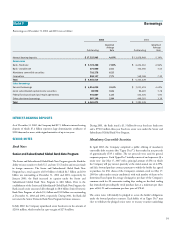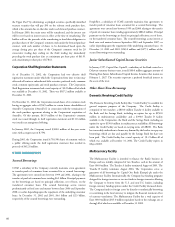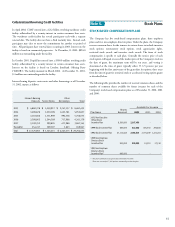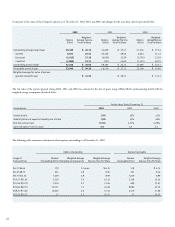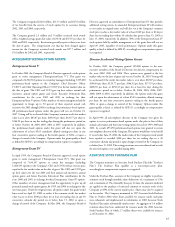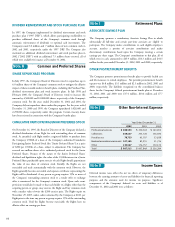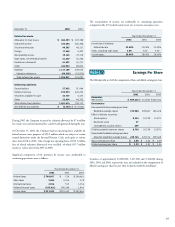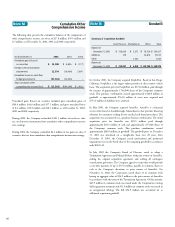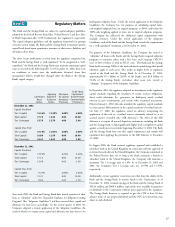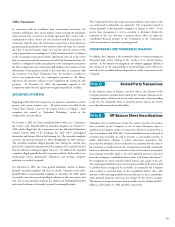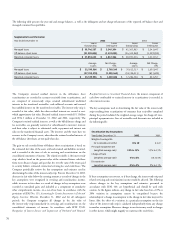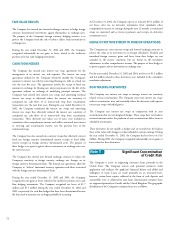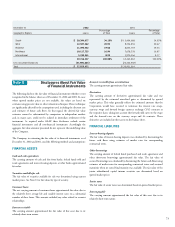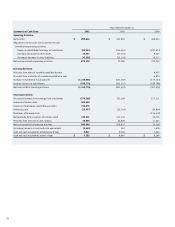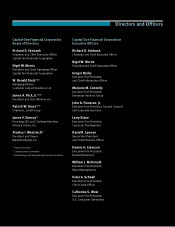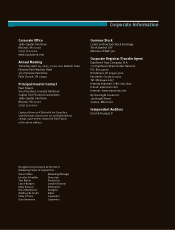Capital One 2002 Annual Report Download - page 71
Download and view the complete annual report
Please find page 71 of the 2002 Capital One annual report below. You can navigate through the pages in the report by either clicking on the pages listed below, or by using the keyword search tool below to find specific information within the annual report.
69
Other Guarantees
In connection with an installment loan securitization transaction, the
transferee (off-balance sheet special purpose entity receiving the installment
loans) entered into an interest rate hedge agreement (the “swap”) with a
counterparty to reduce interest rate risk associated with the transaction. In
connection with the swap, the Corporation entered into a letter agreement
guaranteeing the performance of the transferee under the swap. If at anytime
the Class A invested amount equals zero and the notional amount of the
swap is greater than zero resulting in an “Early Termination Date” (as defined
in the securitization transaction’s Master Agreement), then (a) to the extent
that, in connection with the occurrence of such Early Termination Date, the
transferee is obligated to make any payments to the counterparty pursuant to
the Master Agreement, the Corporation shall reimburse the transferee for the
full amount of such payment and (b) to the extent that, in connection with
the occurrence of an Early Termination Date, the transferee is entitled to
receive any payment from the counterparty pursuant to the Master
Agreement, the transferee will pay to the Corporation the amount of such
payment. At December 31, 2002, the maximum exposure to the
Corporation under the letter agreement was approximately $26.7 million.
SECURITIES LITIGATION
Beginning in July 2002, the Corporation was named as a defendant in twelve
putative class action securities cases. All twelve actions were filed in the
United States District Court for the Eastern District of Virginia. Each
complaint also named as “Individual Defendants” several of the
Corporation’s executive officers.
On October 1, 2002, the Court consolidated these twelve cases. Pursuant to
the Court’s order, Plaintiffs filed an amended complaint on October 17,
2002, which alleged that the Corporation and the Individual Defendants
violated Section 10(b) of the Exchange Act, Rule 10b-5 promulgated
thereunder, and Section 20(a) of the Exchange Act. The amended complaint
asserted a class period of January 16, 2001, through July 16, 2002, inclusive.
The amended complaint alleged generally that, during the asserted class
period, the Corporation misrepresented the adequacy of its capital levels and
loan loss allowance relating to higher risk assets. In addition, the amended
complaint alleged generally that the Corporation failed to disclose that it was
experiencing serious infrastructure deficiencies and systemic computer
problems as a result of its growth.
On December 4, 2002, the Court granted defendants’ motion to dismiss
plaintiffs’ amended complaint with leave to amend. Pursuant to that order,
plaintiffs filed a second amended complaint on December 23, 2002, which
asserted the same class period and alleged violations of the same statutes and
rule. The second amended complaint also added a new Individual Defendant
and asserted violations of Generally Accepted Accounting Principles.
The Corporation believes that it has meritorious defenses with respect to this
case and intends to defend the case vigorously. The Corporation moved to
dismiss plaintiffs’ second amended complaint on January 8, 2003. At the
present time, management is not in a position to determine whether the
resolution of this case will have a material adverse effect on either the
consolidated financial position of the Corporation or the Corporation’s
results of operations in any future reporting period.
OTHER PENDING AND THREATENED LITIGATION
In addition, the Company is also commonly subject to various pending and
threatened legal actions relating to the conduct of its normal business
activities. In the opinion of management, the ultimate aggregate liability, if
any, arising out of any such pending or threatened legal actions will not be
material to the consolidated financial position or results of operations of the
Company.
Note Q Related Party Transactions
In the ordinary course of business, executive officers and directors of the
Company may have consumer loans issued by the Company. Pursuant to the
Company’s policy, such loans are issued on the same terms as those prevailing
at the time for comparable loans to unrelated persons and do not involve
more than the normal risk of collectibility.
Note R Off-Balance Sheet Securitizations
Off-balance sheet securitizations involve the transfer of pools of consumer
loan receivables by the Company to one or more third-party trusts or
qualified special purpose entities in transactions which are accounted for as
sales in accordance with SFAS 140. Certain undivided interests in the pool of
consumer loan receivables are sold to investors as asset-backed securities in
public underwritten offerings or private placement transactions. The
proceeds from off-balance sheet securitizations are distributed by the trusts to
the Company as consideration for the consumer loan receivables transferred.
Each new off-balance sheet securitization results in the removal of consumer
loan principal receivables equal to the sold undivided interests in the pool
from the Company’s consolidated balance sheet (“off-balance sheet loans”),
the recognition of certain retained residual interests and a gain on the sale.
The remaining undivided interests in principal receivables of the pool, as well
as all billed finance charge and fee receivables, are retained by the Company
and recorded as consumer loans on the consolidated balance sheet. The
amounts of the remaining undivided interests fluctuate as the accountholders
make principal payments and incur new charges on the selected accounts.
The amount of retained consumer loan receivables was $6.6 billion and $5.7
billion as of December 31, 2002 and 2001, respectively.


